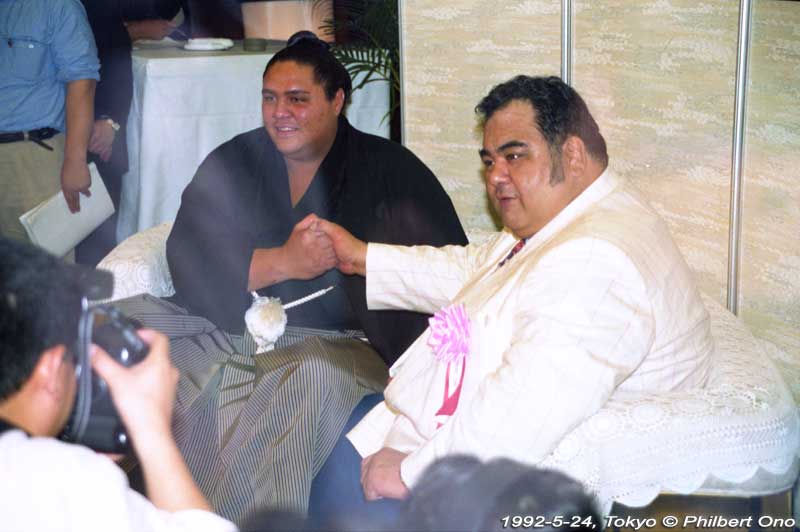
Akebono Tribute Contents
- Azumazeki Stable
- Ozeki Promotion (Current page)
- Yokozuna Promotion
- Retirement Ceremony
Akebono wins the May 1992 sumo tournament, ensuring his promotion to Ozeki. His sumo stable was jam-packed with fans. *This article first published in 1992, updated in May 2023.
By winning the Grand Sumo Tournament in May 1992 in Tokyo, Akebono secured his promotion to ozeki (champion), the doorstep to yokozuna (grand champion). Since Akebono has always been ozeki material, the promotion itself was not at all surprising–the speed at which he achieved it was.
In fact, he did it in record time, after only 26 sumo tournaments following his Spring 1988 debut. Konishiki held the previous record of 30 tournaments. (The record excludes college-graduate wrestlers starting from the makushita division.)
Before the May 1992 tournament started, nobody thought that Akebono would win it. The attention was instead focused on March 1992 tourney winner and yokozuna-candidate Konishiki. Another tournament championship (making it two in a row) would have assured his elevation to yokozuna and his place in history as the first foreign-born yokozuna. However, Konishiki apparently buckled under the pressure and had four humiliating, consecutive losses from the fifth day of the tournament. All eyes soon shifted to Akebono who emerged as the tournament leader, and later, the tournament winner.
Akebono (nicknamed “New Dawn”) was the May 1992 tournament’s powerhouse. His far-reaching, two-hand thrusting attacks were relentless and often sent his opponents flying spectacularly out of the ring. Kyokudozan, the second lightest makunouchi wrestler, flew out of the ring rear end first and landed likewise next to a judge. Kotonishiki almost made a horizontal cartwheel as he was blasted out of the ring.
Akebono also proved his potency on the mawashi (belt) in the match with rival Takahanada (later renamed Takanohana). He started with his usual thrusting attack until Takahanada managed to latch on to Akebono’s mawashi. It was yotsu-zumo (both opponents grasping each other’s belt) then on, and Akebono kept cool and bulldozed Takahanada out and down on the dirt.
Even with fellow Hawaiian Musashimaru, he unleashed a brilliant sukui-nage (beltless throw). He only lost to Konishiki and Akinoshima who side-stepped his thrusting arms and let him fall down on his own. Fortunately, Akebono was not fazed by his losses.
Coming into the final day with only two losses, he had one more hurdle in second-place Wakahanada (later renamed Wakanohana) who had three losses. By that time, there was nothing stopping Akebono. He had this strong spirit and drive, the kind that wins tournaments. He was on track and the Force was with him. I knew he would pull it off.
As the two stepped into the ring, threw salt, and stared at each other, the spectators howled and rooted. Besides the large amount of kensho-kin (encouragement money in the white envelopes handed to the bout’s winner by the referee), there was a lot riding on the match for Akebono. Winning it would give him his first championship and a very possible ozeki promotion. Even before the final day, the judges committee disclosed that it would recommend Akebono for ozeki promotion if he won the tournament. If he lost the bout, he would have to win the play-off.
The showdown match began with Akebono thrusting his long arms to slap and push hapless Wakahanada out of the ring in a matter of seconds. Akebono immediately pumped his right fist on impulse (which he later didn’t recall doing) and helped up Wakahanada with a pat on the arm even. There was no need for a play-off.
In the next and final match of the tournament, Konishiki defeated longtime nemesis Akinoshima but still ended up with a dismal 9-6 tally. Just passing for an ozeki, but no good for a yokozuna candidate.
The awards ceremony was held some minutes later and Akebono stood by to receive the Emperor’s Cup along with a variety of many prizes. U.S. Ambassador Michael Armacost was also on hand to read a congratulatory message in Japanese, which can be translated as follows: “On behalf of President George Bush and the American people, I heartily congratulate you on your first tournament championship. We are proud of your victory and we hope for your further advancement in this ancient and traditional Japanese sport.”
Meanwhile, Akebono’s stablemaster, Azumazeki (formerly Takamiyama), was interviewed by the press and expressed his great joy at Akebono’s victory. “I never thought this would happen,” he said hoarsely as he wiped his teary eyes. It was a touching moment.
In a special TV program later in the evening, he explained, “It’s hard enough just to run even a small stable. But if there’s someone like him (Akebono) who brings a yusho (championship), I forget about all the hardship I went through. I never thought he would come this far. It’s like a dream come true.”
Kokonoe oyakata (former popular yokozuna Chiyonofuji), also on the same program as a commentator, mentioned that the first yusho was always the sweetest and most memorable. “It doesn’t hit home until you get up the next morning and read about it in the papers.” It was almost exactly 20 years ago when Takamiyama experienced what Akebono was going through. And in less than seven years after opening his stable, Azumazeki produced an ozeki. As an active wrestler and now as a stablemaster, he continues to rewrite sumo history books.
After 6 p.m. when the awards ceremony ended, Akebono went back to the shitaku-beya (dressing room) for banzai cheers with the Emperor’s Cup on his lap and supporters behind him raising both arms. A joint press interview was held immediately afterward:
Interviewer (I): “Congratulations.”
Akebono (A): “Thank you very much.”
I: How do you feel now with your first yusho?
A: I am speechless.
I: How did you feel when you received the Emperor’s Cup?
A: It felt like I was in heaven.
I: In today’s bout with Wakahanada, did you plan to go with the thrusting attack?
A: Yes, I wanted to continue using my winning sumo technique.
I: In the last tournament you sometimes worked on the belt. But in this tournament, did you purposely plan to use pushing and thrusting techniques from the start?
A: No, I did not plan on any particular strategy. I just performed naturally.
I: You came from Hawaii just over four years ago. Did you think you could win the Emperor’s Cup so soon?
A: No, not at all.
I: I’m sure you went through a lot of hardship getting used to Japanese life and customs…
A: When something like this happens, I forget about all the hardships.
I: Did you see your stablemaster yet?
A: No, not yet.
I: When you see him, what will you say?
A: Thanks to your help, I was able to take the yusho.
I: Congratulations again.
A: (Bows)
Right after watching Akebono push out Wakahanada on TV, I headed for Azumazeki Stable in Sumida Ward. Akebono would be in a victory parade from the Kokugikan sumo arena to his stable. I waited along the main road leading to the stable.
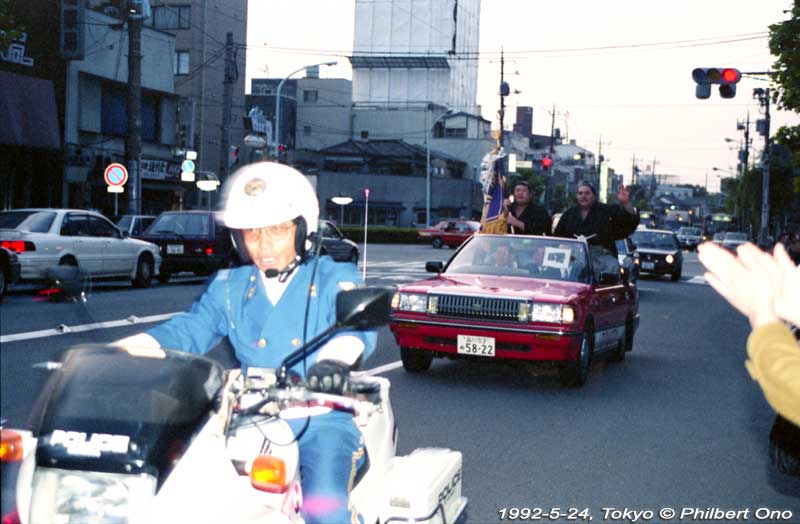
At around 6:40 p.m., Akebono and Takasago Stable wrestler Mitoizumi (“Salt Shaker”) passed by on a police-escorted red convertible while smiling and waving.
Stablemaster Azumazeki, his wife (the okami-san), and about 200 fans and neighbors were waiting in front of the stable. Cheers and party poppers broke out as Akebono arrived amid a shower of streamers and confetti. With bouquets in hand and confetti on his face, he greeted his stablemaster and the kimono-clad okami-san who was in tears.
The jam-packed crowd was chaotic. People were mishmashing to get a better view on the narrow street in front of the stable. The press were on step ladders recording the entire event, and the police tried to control the crowd while guarding the stable entrance.
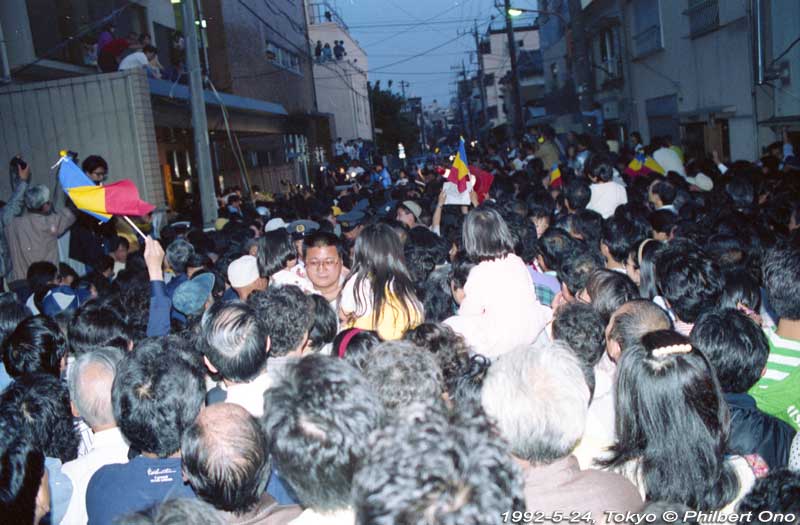
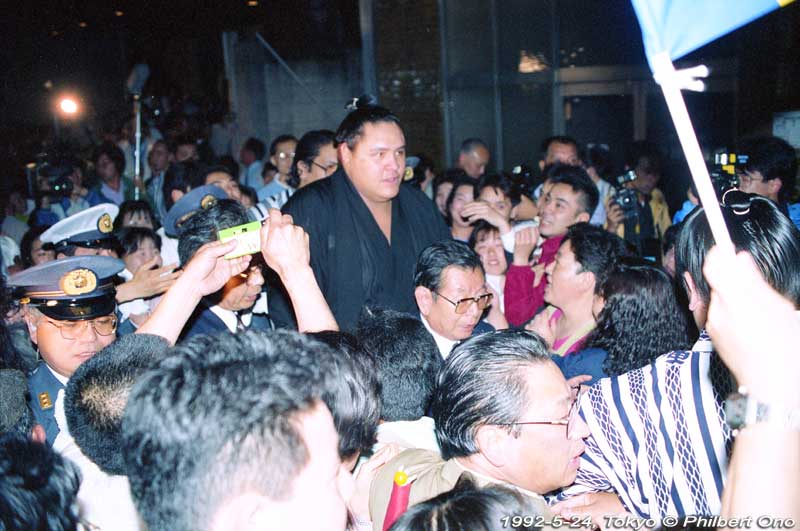
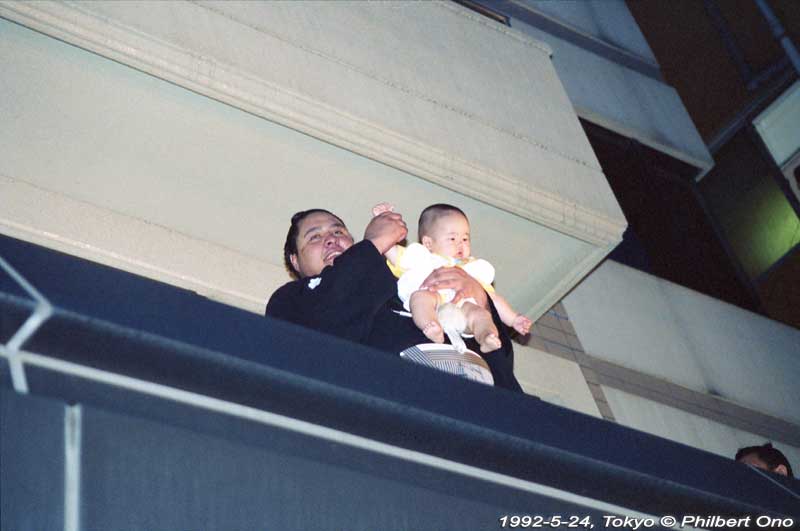
Akebono later stepped out of the stable’s second-floor window and stood on the wide ledge. The crowd cheered wildly and gave a few banzais and the victory clap. All smiles, Akebono acknowledged the cheers, pumped his fist several times, and even held a baby.
After he went back inside, the police announced that the party was over and urged everyone to go home. The obedient crowd gradually dispersed except for a few of us. Akebono and Azumazeki oyakata later came out and got into the stable’s Mercedes to attend a victory party in Iidabashi.
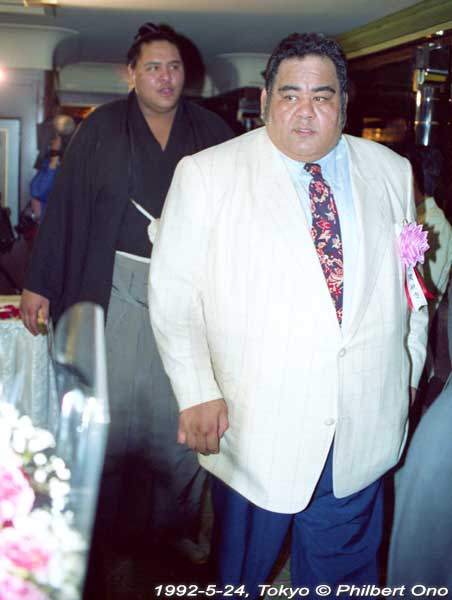
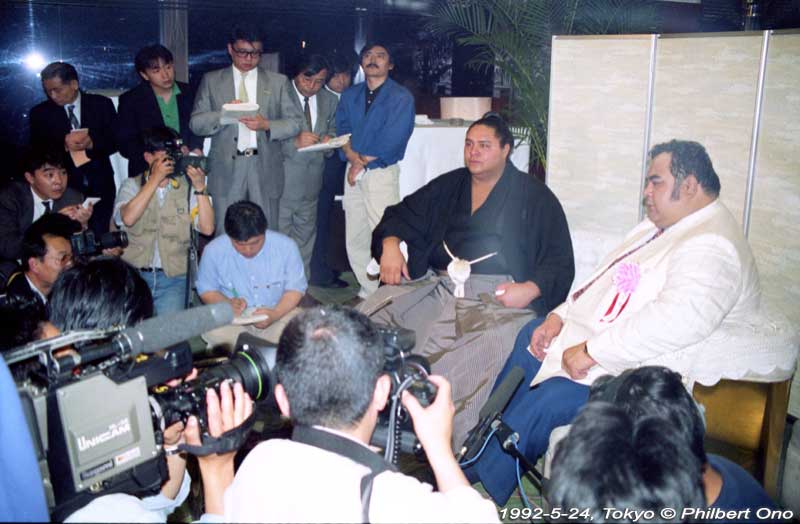
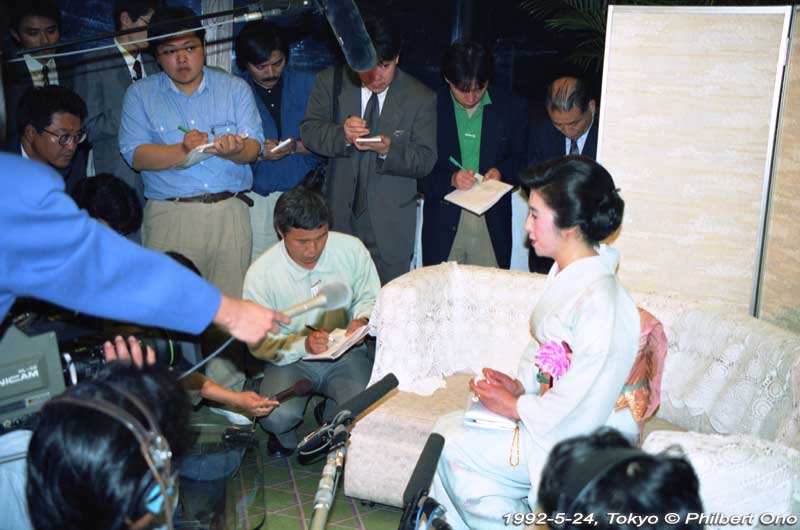
Chad’s bikkuri bikutori (surprising victory) capped an excellent three-tournament record after a runner-up performance (12-3) in the January 1992 tournament and a winning record (8-7) in the March 1992 tournament. It made ozeki promotion imminent.
On the morning of May 27, 1992, just three days after the tournament, Akebono’s widely-expected promotion to ozeki (大関) was formally approved at a Japan Sumo Association Rankings Committee meeting. Right after the meeting, two Sumo Association officials, Kasugano (former yokozuna Tochinoumi) and Nakamura (former Fujizakura), paid a formal visit to Azumazeki Stable to convey the news. After the officials sat in front of a bundle of microphones, they informed Akebono, stablemaster Azumazeki, and the okami-san that the promotion was formally approved.
Akebono bowed and acknowledged and accepted the promotion in Japanese. He promised to do his best to uphold the honor of the rank and not sully it. Then his mind suddenly went blank and he forgot what he supposed to say next. Azumazeki then prompted him with “arigato,” and Akebono ended his response with just “arigato gozaimasu.”
Akebono had watched a video of Konishiki formally accepting ozeki promotion and practiced saying the acceptance lines. But apparently he did not have enough practice or was really nervous and forgot his lines.
During the press conference which followed, it was announced that a dash would be added to the kanji character for Akebono’s name. The kanji for akebono (曙) does have a dash, but Akebono had hitherto omitted it from his name. The dash, called a ten in Japanese, stood for tenka wo toru (come to power). Since he had “come to power” as an ozeki, it was deemed appropriate to finally add that dash.
After the press conference, he went outside the stable to greet the large crowd clapping and shouting “Ozeki! Ozeki!” After being hoisted up by four stablemates (all wearing a yukata with “CHAD” written all over it), he raised both arms with clenched fists for photographers.
For about 10 days afterward, Akebono appeared in various press conferences and TV interviews. When he was on Asahi TV’s News Station program with Kume Hiroshi, he demonstrated his thrusting technique by giving Kume just a very slight push on the shoulders. Kume slipped and fell to the floor with a yelp.
After recovering, Kume inquired, “The tournament winner has to meet with many patrons who invite him out to Ginza, Roppongi, and Akasaka. All this late-night revelry prevents the wrestler from getting enough sumo practice and often results in a poor performance in the next tournament. (Perhaps this explains Takahanada’s collapse in the March tourney after his January victory.) Will you get enough practice for the July tournament?” “Daijobu desu,” (No problem) replied Akebono who is known for his diligent sumo training. Kume also expressed his amazement at Akebono’s excellent Japanese language and sumo skills which were attained in only four years.
In an NHK TV news report, Japan Sumo Association Chairman Dewanoumi (former yokozuna Sadanoyama) commented on Akebono’s promotion. “There are over 800 wrestlers in the Japan Sumo Association, and he’s at the apex. Therefore he has to serve as an exemplary example for the others through his hard training and devotion to sumo.” He added, “He’s really trying hard. I think he will start aiming for yokozuna quite soon.” I think Dewanoumi’s remarks are right on the money.
Almost simultaneously with Akebono’s ozeki promotion, the Japan Sumo Association was reportedly considering to limit the total number of foreign sumo wrestlers to 40 (there were 33 in May) and the number of foreign wrestlers per stable (there are over 40 sumo stables) to only two. The proposal was widely criticized and accusations of racial discrimination were brewing.
However at a press conference, Dewanoumi denied that such limits would be imposed and dismissed the report as only a rumor. That was a relief to hear. A rumor like this was unnecessary especially in the wake of Konishiki’s alleged accusation (right before the May tournament) of racial discrimination as the reason for his non-promotion to yokozuna. (As of 2023, a sumo stable can have only one foreign-born wrestler.)
Of course after the May 1992 tournament, no one needed racial discrimination to block Konishiki from becoming yokozuna. His disappointing 9-6 record threw his tsuna-tori (yokozuna promotion) out the window and set him back to square one. This pleased the traditionalists opposing a gaijin yokozuna.
If he became yokozuna, he would have most likely faltered like recent yokozunas Futahaguro, Onokuni, and Asahifuji and be forced to retire prematurely. This would not be good, not only for the sumo world, but also for future gaijin yokozuna candidates. Konishiki is still too bulky and slow on his feet, and he does not have the aura of invincibility. When he loses, he loses badly. In May, his loss to lightweight Kyokudozan was especially embarrassing when he fell flat on his belly right after the initial charge. A gaijin yokozuna would be great, but only if he can perform up to yokozuna standards.
The truth is, a rikishi (sumo wrestler) of true yokozuna caliber is rare. So rare that the Sumo Association has resorted to promoting less-deserving ozeki just to ensure an adequate supply of yokozuna. This has resulted in a number of mediocre or poor-performing yokozuna in recent years.
The Sumo Association has wisely raised its standards for yokozuna promotion. The higher standards have affected Konishiki’s chances for promotion. The Association is standing firm and apparently wants an outstanding yokozuna or none at all. Since all the yokozuna have retired and no one can meet these standards right now, professional sumo is without a yokozuna for the first time in 62 years.
This brings us back to Akebono. Since everyone wants to see a yokozuna, it’s prime time for a yokozuna candidate to make his move now. Although Akebono is still far off from making the grade, he is a leading contender. He is young at 23 and has quite some time to wage a campaign for yokozuna promotion. We just have to see how he performs during the rest of 1992.
If he does well, he could become a yokozuna in 1993 (which he did). I can see no problem with his character and hinkaku (dignity and grace)–he is very well-mannered. He just has to become a more versatile rikishi, perform well consistently, and win two more tournaments.
With Akebono frequently in the limelight, the public is finally getting to know and like the tallest ozeki in history. More people now know his real name and call him “Chad.”
He has beaten the Waka-Taka brothers for ozeki promotion, even though Takahanada/Takanohana grabbed a yusho (tournament victory) first. Akebono has publicly declared the Waka-Taka brothers to be his main rivals. Even in the May 1992 tournament, he relished his victory over Takahanada the most. This is understandable since Waka, Taka, and Akebono entered sumo the same time. Without a doubt, this healthy rivalry will continue for a long time. (After retirement, it remained a friendship and bond forever.)
We all looked forward to seeing Akebono make his debut as ozeki (and as the highest-ranking rikishi) in the July 1992 tournament in Nagoya. Unfortunately, he injured a toe during practice about a week before the tournament. He still wanted to enter the tournament, but his stablemaster regretfully decided that it was best for him to skip the tourney (which would automatically give him a losing tournament record) and heal the injury.
This put Akebono in kadoban status, which means he is subject to demotion unless he attains a winning record in the next tournament, which will be in September 1992. An ozeki with two successive losing tournaments is demoted.
I am sure that he will not be fazed by the premature threat of demotion and will make a strong comeback in September 1992 to make up for lost time. It would be difficult to imagine him performing poorly in September and losing his rank. We just have to pray that he does not get injured at critical moments in his career.
Next page here (Yokozuna Promotion)…
Akebono Tribute Contents
- Azumazeki Stable
- Ozeki Promotion (Current page)
- Yokozuna Promotion
- Retirement Ceremony